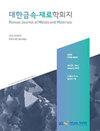Effect of Single Crystal Growth and Solidification Grain Boundaries on Weld Solidification Cracking Behavior of CMSX-4 Superalloy
IF 1.4
4区 材料科学
Q4 MATERIALS SCIENCE, MULTIDISCIPLINARY
引用次数: 0
Abstract
Single-crystal superalloys have been popularly employed in high-temperature parts of gas turbines, such as blades. However, the welds of such alloys are highly susceptible to solidification cracking, which limits their applicability to high-temperature turbine blades. In this study, the effects of characteristics of weld solidification on solidification cracking susceptibilities (solidification brittle temperature range, BTR) were fundamentally investigated for the CMSX-4 single-crystal superalloy. We applied a transverse-Varestraint test procedure for both the linear and oscillated arc welds by changing the weld solidification characteristics, such as the degree of single crystal growth and formation of solidification grain boundaries. The BTR for the CMSX-4 alloy is 336 K for linear welding condition, whereas the values are 434 K and 342 K for 0.6 and 1.5 Hz oscillated welds. Interestingly, the BTR continuously increases with the weld oscillation frequency. By contrast, almost no changes in the weld mushy-zone temperature range are theoretically calculated for each welding condition via the diffusion-controlled Scheil model. The mechanism underlying the increase in BTR under oscillation welding is clarified based on the relationship between the achievement ratio of the weld single crystal growth and fraction of high-angle (>15o) solidification boundaries, which affect severe dendrite coalescence undercooling. The lower fraction of the high-angle weld solidification grain boundaries attributed to the superior achievement ratio of weld single crystal growth, which reduces the dendrite coalescence undercooling and BTR. Consequently, it enhances the solidification crack propagation resistance.单晶生长和凝固晶界对 CMSX-4 超合金焊接凝固裂纹行为的影响
单晶超级合金已广泛应用于燃气轮机的高温部件,如叶片。然而,这类合金的焊缝极易产生凝固裂纹,这限制了它们在高温涡轮叶片中的应用。本研究从根本上研究了 CMSX-4 单晶超合金的焊缝凝固特征对凝固裂纹敏感性(凝固脆性温度范围,BTR)的影响。通过改变焊接凝固特性(如单晶生长程度和凝固晶界的形成),我们对线性电弧焊和摆动电弧焊采用了横向-Varestraint 试验程序。线性焊接条件下,CMSX-4 合金的 BTR 为 336 K,而 0.6 和 1.5 Hz 振荡焊接条件下的 BTR 值分别为 434 K 和 342 K。有趣的是,BTR 随焊接振荡频率的增加而持续增加。相比之下,通过扩散控制的 Scheil 模型,理论上计算出每种焊接条件下的焊接熔化区温度范围几乎没有变化。根据焊缝单晶生长实现率与高角度(>15o)凝固边界比例之间的关系,阐明了振荡焊接下 BTR 增加的机理。高角度焊接凝固晶界的比例越低,说明焊接单晶生长的实现率越高,从而降低了枝晶凝聚过冷度和 BTR。因此,它增强了凝固裂纹扩展阻力。
本文章由计算机程序翻译,如有差异,请以英文原文为准。
求助全文
约1分钟内获得全文
求助全文
来源期刊

Korean Journal of Metals and Materials
MATERIALS SCIENCE, MULTIDISCIPLINARY-METALLURGY & METALLURGICAL ENGINEERING
CiteScore
1.80
自引率
58.30%
发文量
100
审稿时长
4-8 weeks
期刊介绍:
The Korean Journal of Metals and Materials is a representative Korean-language journal of the Korean Institute of Metals and Materials (KIM); it publishes domestic and foreign academic papers related to metals and materials, in abroad range of fields from metals and materials to nano-materials, biomaterials, functional materials, energy materials, and new materials, and its official ISO designation is Korean J. Met. Mater.
 求助内容:
求助内容: 应助结果提醒方式:
应助结果提醒方式:


